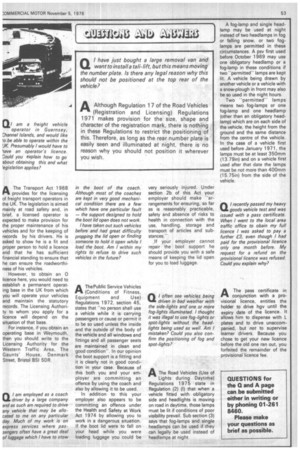Q I often see vehicles being driven in bad weather with
Page 55

If you've noticed an error in this article please click here to report it so we can fix it.
the side-lights and one or more fog-lights illuminated. I thought it was illegal to use fog-lights or spot-lights without the headlights being used as well. Am I mistaken? Could you also confirm the positioning of fog and spot-lights?
The Road Vehicles (Use of Lights during Daytime) Regulations 1975 state in Regulation (2) (I) that when a vehicle fitted with obligatory side and headlights is moving on road in daytime, those lamps must be lit if conditions of poor visibility prevail. Sub section (3) says that fog-lamps and single headlamps can be used if they can legally be used instead of headlamps at night.
A fog-lamp and single headlamp may be used at night instead of two headlamps in fog or falling snow, or two foglamps are permitted in these circumstances. A psv first used before October 1969 may use one obligatory headlamp or a fog-lamp in these conditions if two -permitted" lamps are kept lit. A vehicle being drawn by another vehicle or a vehicle with a snow-plough in front may also be so used in the night hours.
Two "-permitted" lamps means two fog-lamps or one fog-lamp and one headlamp. (other than an obligatory headlamp) which are on each side of the vehicle, the height from the ground and the same distance from the centre of the vehicle. In the case of a vehicle first used before January 1971, the lamps must be at least 350mm (13.79in) and on a vehicle first used after that date the lamps must be not more than 400mm (15.75in) from the side of the vehicle.
































































































